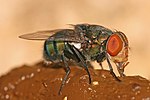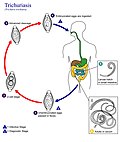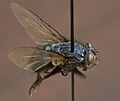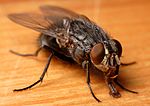Chrysomya rufifacies is a species belonging to the blow fly family, Calliphoridae, and is most significant in the field of forensic entomology due to its...
15 KB (1,976 words) - 02:33, 20 September 2021
Chrysomya is an Old World blow fly genus of the family Calliphoridae. The genus Chrysomya contains a number of species including Chrysomya rufifacies...
17 KB (1,923 words) - 22:34, 5 October 2023
than C. rufifacies. Both species had a lighter adult weight than normal and pupated earlier. The third instar of C. rufifacies will eat Chrysomya megacephala...
23 KB (2,780 words) - 10:57, 10 July 2024
current infestation. Chrysomya bezziana belongs to the genus Chrysomya, which contains species like Chrysomya rufifacies and Chrysomya putoria. C. bezziana...
19 KB (2,752 words) - 00:29, 19 September 2023
rufifacies (but not all rufifacies so this character is unreliable)).There are minor differences in larval morphology. The taxonomy of C. rufifacies is...
7 KB (805 words) - 00:25, 19 September 2023
whether the Old World screwworm, Chrysomya rufifacies, is present in the maggot masses on the body, because C. rufifacies is usually after C. macellaria...
31 KB (3,695 words) - 06:54, 28 June 2024
vulpis. Non-biting cyclorrhaphan flies (Musca domestica, M. sorbens, Chrysomya rufifacies, C. bezziana, Lucina cuprina, Calliphora vicina and Wohlfarthia magnifica)...
28 KB (3,148 words) - 17:48, 23 January 2024
(July 2005). "First report of human myiasis caused by Chrysomya megacephala and Chrysomya rufifacies (Diptera: Calliphoridae) in Thailand, and its implication...
80 KB (10,234 words) - 21:36, 25 July 2024
50:50, but one exception is females from two species of the genus Chrysomya (C. rufifacies and C. albiceps), which are either arrhenogenic (laying only male...
43 KB (4,135 words) - 18:14, 25 April 2024
coeruleiviridis, include Cochliomyia macellaria, Chrysomya rufifacies, Phormia regina, Chrysomya megacephala, and Calliphora vicina. Other important...
11 KB (1,520 words) - 12:11, 4 April 2021
days prior. Two species of Diptera (Calliphoridae), Chrysomya megacephala and Chrysomya rufifacies, found on the corpse and tissue samples from the body...
13 KB (1,865 words) - 17:48, 21 March 2023
Australia, Lucilia cuprina causes about 90% of infestations, and Chrysomya rufifacies is the most common secondary pest that targets wounds caused by L...
4 KB (548 words) - 10:56, 27 April 2024
livida, Lucilia cuprina, Lucilia sericata, Lucilia illustris, Chrysomya rufifacies, Chrysomya megacephala, Cochliomyia macellaria, and Protophormia terraenovae...
12 KB (1,541 words) - 12:04, 2 December 2023
very large and predacious. They are known to devour the larvae of Chrysomya Rufifacies, commonly known as the hairy maggot blow fly. The S. nudiseta flies...
11 KB (1,481 words) - 09:38, 17 June 2022
Borbororhinia bivittata Caiusa testacea Chrysomya megacephala Chrysomya nigripes Chrysomya pinguis Chrysomya rufifacies Chrysomya villeneuvi Cosmina simplex Hemipyrellia...
57 KB (3,843 words) - 12:53, 9 April 2024
Machine Williams, KA; Villet, MH (Dec 2006). "A new and earlier record of Chrysomya megacephala in South Africa, with notes on another exotic species, Calliphora...
12 KB (1,323 words) - 00:11, 19 September 2023












